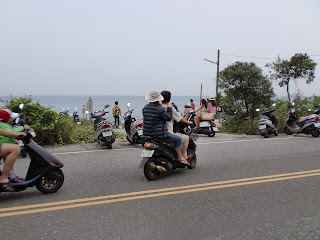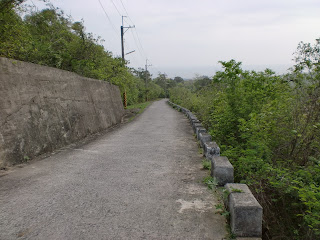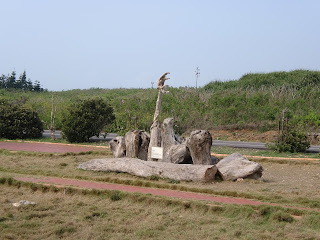Day two of my trip to Lamay Island. We woke up bright and early (well, sort of) and I took a couple of photos of the camp area.
小琉球の旅、二日目。朝(まあまあ)早く起きて、泊まっているところの写真を撮った。
小琉球的旅行、第二天。我起床了就拍我們住的地方的照片。
Hardcore, nature enthusiasts would probably point out that this is camping only in the same way that pitching a tent in your backyard is camping, and that's true, but look at the view from this cliff that we were on! If it were clearer, we probably could have seen mainland Formosa.
確かに大自然の中の本番のキャンピングじゃないけど、崖の上からの景色は抜群に綺麗だ。
這個風景真的不錯吧!(當然我說的是上面。不是下面的照片。)
We spent this day cycling around to Lamay's tourist spots. The one they seem to like to advertise the most is this rock:
最初に、島の北東部の港辺りに戻って、有名な「花瓶石」を見に行った。
我們這天騎腳踏車順時針地環繞島。最初靠「花瓶石」看看了。
It's called "Flower Vase Rock", and it is pretty neat.Next to Flower Vase Rock was a temple with some neat guardian dog/lion things.
花瓶石の隣りに有ったシーサーも面白いと思った。顔は結構独特だ。
我喜歡花瓶石旁邊的石獅子。他們的臉很特別。
The Flower Vase Rock is near the port on the north-east coast of the island. After visiting it, we started to head around the island in a clockwise direction, staying near the coast. At the first lookout point, we received a lesson on the dynamics of heavy rainfall and loose soil.
港を離れて、時計回りして島の一周を始めた。最初に着いた展望台にこう言う風景も有った:
あらあら、、、
でもそれ以外は綺麗だった。花も有ったし。
There were also pretty flowers and old-timey bicycle statues.
昔の自転車の彫像も有ったし。
そして、続いたら、廟に到着して、麒麟ビールの真似をしている様な動物の写真を撮った。小琉球には廟が人口の割合的にめっちゃ多い。
A stop at a local temple (of which there are an awful lot for an island with such a small population) where I took a photo of the local Kirin Beer logo impersonator.
そして、もう一回「小琉球国民小学」に戻って来た。昼間にも写真撮りたかったからね。ほら、「琉球国」って書いている!面白いだろう?
一天以前也去了小琉球國民小學、可是我想在白天再一次去。
I stopped by this elementary school again to photo the sign in daylight. The sign is interesting if you can read Chinese characters, because the placement of the word for "country" comes right after the Chinese name for the island, Lewchew. (I'm using one of the funky, way-cool historic spellings here. Ryukyu and Liuqiu are the more standard spellings, one which would be used when you are translating from Japanese, and the other for Chinese.)
So why is this cool? There was a Lewchew Kingdom, which you surely already know about since I wrote about it in previous blog posts about my trip to Okinawa. You have committed all of my frighteningly interesting posts to memory, right?
At any rate, the character for country in this sign is related to the fact that the public elementary schools in Taiwan are controlled at the national level, so the school is a "national" elementary school. The "Lewchew" that appears before that is because this island is known as "Small Lewchew" in Chinese, perhaps because the island is made of coral, like many of the islands in Okinawa which were part of the Kingdom of Lewchew, or perhaps in reference to the fact that way back when, many Chinese, and by extension European, maps referred to the Taiwan area as "Lewchew Minor" and the Okinawa area as "Lewchew Major". This despite the fact that the island of Formosa is way bigger than all of the Okinawan islands combined. (It was because Okinawa had a Kingdom with a king who lived in a palace and wore fancy hats, while the inhabitants of Formosa belonged to smaller groups who did more hunting and were therefore considered less civilized and therefore less important. Though they did wear fancy hats too.) I actually don't know why the island is called "Small Lewchew" in Chinese.
So basically, the sign says "Small Lewchew National Elementary School", but if you cut off the small at the front, it looks like it is a national school of the independent country of Lewchew, a country that no longer exists. That's what I thought was cool. And yes, I did drag my travel buddy here twice just to take pictures of the sign. She was very patient with me.
拍照片以後、再去對面的刨冰店。不但好吃、老闆也很友善。
この写真を撮る為にわざわざここに戻って来たので、一緒に旅した友達にお礼を言いたい。変な我が儘なお願いでご免ね。
でも結局良かった。もう一回昨日の夜に行ったかき氷屋さんに行けたから。オーナーも二人とも優しかったし、かき氷も美味しかったし、景色もこう言う感じ成っている:
After taking important photos of signage, we went across the street to this shaved ice store. We actually had stopped in here the previous night, and the owners were very friendly, and the mango ice was extremely delicious, so we came again. Shaved ice in Taiwan is typically served in huge bowls with lots of fresh fruit and syrup all over the place. I've never seen shaved ice on quite the same level in the US, though it wouldn't surprise me if it exists in neighborhoods with large Asian populations. I bet it costs at least three times as much in the US though.
続いて、このビーチで停まって海岸の景色を味わった。そこで下の写真を撮ったけど、気付いているかな。誰もヘルメットかぶっていない。台南には珍しくない事だけど、多くの人はちゃんとヘルメットをかぶる。でも小琉球は本当に滅多にヘルメット見掛けなかった。島の警察は凄く交通規制に対して緩いみたいだ。
有的時候在臺南也看到沒戴安全帽的人、可是大部分的人戴著。不過、在小琉球戴安全帽的人非常少。
Another interesting thing I noted during this trip: While you do see the occasional helmet-less scofflaw in Tainan, the majority of scooter riders do wear helmets. When we got to Donggang (covered in the last post) I noticed way more people riding without helmets. When we got to Lamay Island, I saw almost no one wearing a helmet. Apparently the police on Lamay don't enforce helmet laws. Is there generally a correlation between traveling south in Taiwan and disregard for scooter helmet laws? Further study is warranted.
Pretty cool beach!
Hey, it was pretty hot out.
珊瑚礁で出来た岩ってところはかなり沖縄に似ている。
Above: Another weird rock formation.
Below: The author of this blog, possibly engaging in risky photographing-while-riding behavior, or perhaps taking photos after having stopped his bike by the side of the road. More cool rock formations and more law-breaking on view.
その後島の南部に有る灯台を見に行った。台湾海峡を通っている船を案内している、この灯台は国際灯台とされているらしい。船が見える様に丘の上に施設されている。多分島の最高点だと思う。そのせいで、自転車でそこに行くのは最悪にキツい。マジで死ぬかと思った。
We wanted to visit the international lighthouse on Lamay. Of course, since it has to be very visible, it's on top of a tall hill, probably the biggest hill on the island. This is a photo from the middle of our death-ride up the hill. I'll admit, we walked a lot. You would have too. I didn't even have access to all of my gears on my bike because the front shifter wouldn't shift out of the middle gear.
後來騎上山去、看看小琉球的國際燈塔。它在島的最高點、所以去得很累。
途中でこの老樹が居らした。
There was a really old tree on the way up.
Below, walls that must have been outside of a structure at one point. There was no structure visible, and a disappointing lack of signage.
And here we are at the steps to the lighthouse!
やっと着いた!この階段を登れば灯台が有る!
でもその前に無理して蝶々の写真を撮ろうとした。
I tried in vain to get a nice photo of a butterfly. It's the fuzzy glop in the photos above and below.
これだ!うわ〜、格好いい!
Awesome!
好帥!
Art Photos.
こっちから撮ったら、日差しは写真の写し方を影響した。
この灯台は1929年に建てられたので、これも日本政府が作った施設だ。
And here's the view we saw on the way back down the hill from the lighthouse.下って行ったら、この風景が待っていた。
騎下山的時候看到了這個風景。
We kept going around the island, and we stopped at this lookout point on the south-west coast. This is the place you are supposed to come to see awesome sunsets. We didn't have time for that since we were planning to get on a boat home that day, but we checked out the view a bit.
最後去了這裡。這裡是島西部的把日沒看得清楚的一個地方。
この展望台は島の西部に有る。日没を観察する場所とされている。
ART
看到了大大的船。
There was some large ship in the distance.
日没は見えなかったけど、この船が見えた。
I have some more scattered photos from our trip up the west coast of the island. I don't have much to say about them, but they're pretty. (By the way, did you know that you can see the photos in a larger size if you click on them? I didn't for the longest time, and it's my blog.)
残りの写真は西海岸のあっちこっちの写真だ。もう午後だったので、最後の船に間に合う様に急いで港に戻った。
間に合った!最後の便に乗れた。
And here we are at the port waiting for the last ferry of the day, which we were able to get on.
我們來得及了最後的船回本島來了。
小琉球はあまり大きくないので、南台湾に住んでいる人なら、二日間をかけて見るのはちょうどいいだろう。自転車じゃなくて、バイクを運転する人はもっと余裕が有る。チャンスが有れば、是非行ってみてね。
Lamay Island is a pretty nice weekend trip if you're in southern Taiwan and can get there in a reasonable amount of time. Two days is plenty of time to see the island too, especially if you rent a scooter instead of a bicycle.That's it!
因為不太大、只有兩天還可以去小琉球好好地玩。尤其是住在臺灣南方的人比較容易地過得去。我推薦大家去看看。






























































